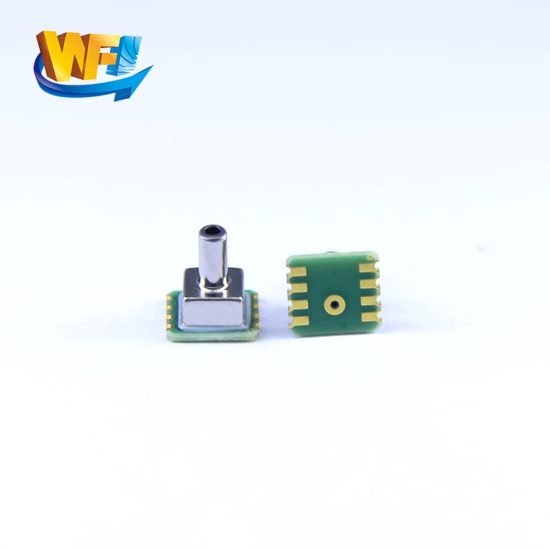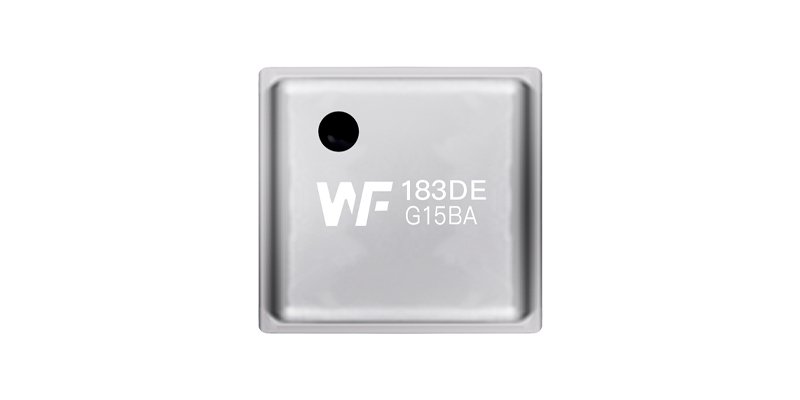Wearable sensor systems need accuracy, tiny size and low power, while staying stable through posture changes, altitude shifts and motion. MEMS pressure sensors are ideal: small, digital and robust. In wrist devices their pressure data correct optical readings, detect motion, adjust for wrist-to-heart height and fuse multi-modal inputs, so health readings are more reliable. The sections below lay out the details.
목록
1. Ambient pressure compensation and accuracy gains
How pressure compensation improves blood-pressure and SpO2 readings
Altitude and cabin pressure changes directly affect wrist-worn blood-pressure and SpO2 sensors. At about 3,000 m the atmospheric pressure is ~70 kPa versus 101.3 kPa at sea level—a ~30% drop that shifts the PPG baseline. Feeding real-time MEMS pressure readings into compensation algorithms can correct optical outputs and cut blood-pressure error from ±15 mmHg to ±8 mmHg.
SpO2 sensors also see shifts in red/infrared absorption ratios across pressures. A MEMS sensor covering roughly 300–1100 hPa, followed by digital filtering and Kalman calibration, can trigger a fast recalibration when pressure jumps; parameters converge within ~5 seconds. In tests, enabling pressure compensation halved SpO2 standard deviation from 1.8% to 0.9%.
Temperature couples with pressure too. Even with on-chip temp compensation, ambient swings can add ±0.3 hPa drift. In wearables, pressure and temperature samples must be time-synced within ~10 ms; using a 2-D lookup table plus personalised corrections reduces temp-induced error to about ±0.1 hPa. That matters for cuffless blood-pressure on cold days, where wrist cooling causes vasoconstriction and pressure data help separate temperature effects from true blood-pressure changes.

2. Motion state recognition and posture calibration
Using tiny pressure changes to spot motion and correct wrist measurements
Wrist vertical motion in running or jumping causes short pressure blips of ~0.1–0.5 hPa. A MEMS pressure sensor sampled at 10 Hz or higher, combined with tri-axial accelerometer frequency features, can classify a dozen movement modes—walking, cycling, swimming, etc. If sustained pressure oscillation and RMS acceleration exceed ~1.2 g, the system flags vigorous motion, pauses blood-pressure measurements and enables anti-motion algorithms. This dual check cuts false alarms versus accelerometer-only logic by about 40%. Fused digital sensors switch state within ~200 ms to avoid wasted readings and save power.
Wrist height relative to the heart causes a hydrostatic offset of roughly 8 mmHg. Ambient pressure sensing can estimate wrist-to-heart vertical distance and apply a gradient correction (for example ~1.3 mmHg per 10 cm), so the pressure sensor needs height resolution near ±8.5 cm (≈ ±1 Pa). If wrist height deviates more than ~20 cm, the device vibrates and delays measurement to meet clinical reference standards.
Systems also log pressure and posture trends to build daily activity profiles. A seven-day sliding window of pressure data plus ML can predict activity level for the next two hours, letting the device adjust sampling to balance data quality and battery life.
3. Multi-sensor collaborative data fusion
Cross-checking pressure with optical sensors and building multi-modal models
In wearables, pressure sensors work alongside SpO2, blood-pressure and motion sensors to boost signal reliability. Estimated altitude from pressure versus measured SpO2 should align—SpO2 drops roughly 3–5% per 1,000 m. If the two differ beyond a threshold the system flags the reading and requests a re-measurement. This cross-check drops SpO2 false positives from ~12% to ~3%.
A 3-D model using wrist skin temperature, ambient pressure and PPG waveform feeds a multivariable regression to predict blood pressure. In cold, high-pressure or hot, low-pressure conditions the model adds terms for vasoconstriction or dilation. Typically a base model trains in the cloud, then personal data fine-tune it; after ~30 days of adaptation prediction error can fall to around ±6 mmHg—near cuff-based device accuracy.
Timing matters: pressure sensors often update at 1 Hz while PPG runs at 50 Hz+. Using a shared 32 kHz clock and spline interpolation to align low-rate pressure with high-rate optical data keeps sync error under ~5 ms, which improves motion-artefact suppression by ~25%.
4. Real-world scenarios and technical challenges
How wearables perform in extremes and everyday office life
On high-altitude trips, a rapid air-pressure drop can signal fast ascent. If pressure falls >10 hPa in an hour the device raises SpO2 sampling to every five minutes; persistent SpO2 <90% for 30+ minutes triggers an altitude-illness alert. Fusing pressure-based altitude with GPS via a Kalman filter gets elevation accuracy to ±5 m—helpful for hikers—and pressure trends can give a 2–3 hour early weather cue.
In aircraft, cabin pressure sits around 75–85 kPa (~2,400 m equivalent). Detecting a quick drop from 101 kPa to ~80 kPa switches the device to flight mode: wrist blood-pressure readings are suspended because turbulence and seating pressures distort PPG, while SpO2 monitoring continues. During long flights the system logs hourly health summaries (SpO2 range, HRV) for at-risk users; normal operations resume after landing.
Offices are stable (pressure swings <2 hPa), ideal for precision monitoring. Devices can boost pressure sampling to 10 Hz to catch small events like HVAC cycles or window openings. Longitudinal pressure–blood-pressure correlations identify weather-sensitive users; a 24-hour drop >8 hPa can trigger proactive tips. Combining accelerometer data, if wrist height changes little for 90 minutes with no pressure oscillation, the system flags prolonged sitting and issues an activity prompt.
Challenges remain: fast personalisation of models, balancing edge compute and accuracy with response time and battery life, and ensuring robust, waterproof packaging and reliable skin contact in wearable form-factors.
5. Implementation and system integration
Sensor selection, circuitry and algorithm deployment
Hardware typically uses absolute-pressure MEMS sensors (eg ST LPS22HH) with ranges ~260–1260 hPa, standby current down to a few µA, accuracy near 0.5 hPa and noise about 0.65 Pa. Packages can be ≤2×2 mm and <0.8 mm thick to fit watches. Interfaces are commonly I²C, SPI or MIPI I3C.
Design uses a low-drop regulator (eg 1.8 V) for the sensor to isolate it from processor supply noise. A waterproof, breathable membrane (ePTFE, ~0.2 µm pores) keeps pressure communicated while blocking liquids and dust to meet wearable protection needs.
On the firmware side, raw pressure goes through median filtering, then a first-order Butterworth low-pass (~0.5 Hz) and is aligned with accelerometer data to decide motion state. Implementations use fixed-point math with quantised coefficients so a Cortex-M4 can compute an update in <2 ms at ~0.5 mW. A lightweight ML blood-pressure predictor uses features like pressure, pressure-rate, temperature, wrist height, PPG shape parameters, HR and age—about 3,000 parameters. After training the model is quantised to INT8 (~12 KB); inference takes ~15 ms and ~80 KB RAM, allowing offline operation. Weekly uploads during charging let the companion app send new data for incremental model updates.
Overall, MEMS pressure sensors simplify integration for wearables thanks to miniaturisation, low power and digital outputs, delivering reliable environmental context for physiological sensing.
결론
Viewed from wearable health monitoring, MEMS pressure sensors are the environmental link in the measurement chain. They provide ambient compensation, motion and posture context, and deep collaboration with blood-pressure, SpO2 and motion sensors to form an environment–physiology coupled monitoring system. Hardware, circuit and algorithm choices must be tuned for wearables to reach high accuracy, low power and small size. For manufacturers, exploiting pressure-based environmental data and integrating it with digital sensors is a practical route to stronger wearable health products.
위의 소개는 압력 센서 기술 적용의 표면적인 부분에 불과합니다. 우리는 다양한 제품에 사용되는 다양한 유형의 센서 요소, 작동 방식, 장점과 단점을 계속해서 탐구할 것입니다. 여기에서 논의된 내용에 대해 더 자세히 알아보려면 이 가이드 뒷부분의 관련 콘텐츠를 확인하세요. 시간이 촉박한 경우 여기를 클릭하여 이 가이드의 세부정보를 다운로드할 수도 있습니다. 공기 압력 센서 제품 PDF 데이터.
다른 센서 기술에 대한 자세한 내용은 다음을 참조하십시오. 센서 페이지를 방문하십시오.


